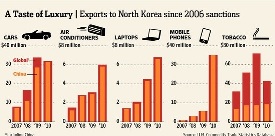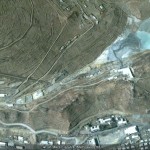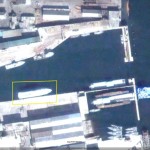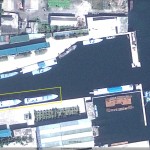You can download a PDF of the Bank of Korea’s report here.
I have a collection of previous Bank of Korea reports on the North Korean economy here.
Yonhap reports on the findings:
The North Korean economy contracted for the second straight year in 2010 due to tougher international sanctions and sluggish agricultural production, the South Korean central bank estimated Thursday.
The Bank of Korea (BOK) estimated that the communist country’s economy shrank 0.5 percent on-year last year, compared with a 0.9 percent contraction in 2009. The data stood in sharp contrast to the 6.2 percent expansion of the South Korean economy in 2010.
The North Korean economy grew 3.1 percent in 2008 on one-off factors after shrinking 1 percent in 2006 and 1.2 percent in 2007, when heavy flooding hit its agricultural production and its relations with the international community deteriorated.
“Last year, the North Korean economy contracted as economic conditions at home and abroad worsened amid energy shortages and international sanctions and its manufacturing sector remained sluggish,” said Park Yung-hwan, an official at the BOK.
North Korea suffers chronic food and energy shortages due to years of isolation, mismanagement and natural disasters. The communist state has relied on international handouts since 1995 to help feed its more than 20 million people.
Last year, inter-Korean relations turned sourer following the North’s deadly sinking of a South Korean warship in March and its shelling of a border island in November.
The North’s agricultural and fishery industry contracted 2.1 percent last year from a year earlier, more than double the 1 percent fall of 2009. Its manufacturing sector declined 0.3 percent in 2010.
North Korea’s nominal gross national income (GNI) amounted to 30 trillion won (US$26.5 billion) last year, which is only 2.56 percent of South Korea’s GNI of 1,173 trillion won.
Meanwhile, inter-Korean trade grew 13.9 percent on-year to $1.91 billion, the BOK said.
Park said although chilly inter-Korean relations and following economic sanctions cut off trade such as humanitarian aid, shipments of goods produced at the Kaesong industrial complex rose.
The value of North Korean products shipped the South reached $1 billion last year, up 11.7 percent from the previous year. South Korean shipments to the North grew 16.6 percent to $868.3 million.
Bloomberg reports on the findings here:
North Korea’s economy shrank for two consecutive years as cold weather and rain hurt farming and power and raw material shortages cut industrial output, South Korea’s central bank said.
Gross domestic product contracted 0.5 percent in last year after a 0.9 percent decline in 2009, according to an estimate published by the Bank of Korea in Seoul today. Measured using nominal gross domestic product, a figure that isn’t adjusted for inflation, North Korea’s GDP totaled 30 trillion won ($26.5 billion) in 2010, compared with South Korea’s 1,173 trillion won, the central bank said in an e-mailed statement. North Korea’s per capita income was 1.24 million won while South Korea’s was 24 million won, according to the estimate.
“Major industries were hampered by bad weather, poor energy and raw material supply, and the international economic sanctions on the country,” the Bank of Korea said.
North Korea has relied on economic handouts since the mid-1990s when an estimated 2 million people died from famine, according to South Korea’s central bank. The United Nations and the U.S. last year increased economic sanctions imposed on the country as a result of its nuclear weapons activities after attacks that killed 50 South Koreans.
South Korea, whose economy is 40 times larger than North Korea’s, plans to set up a fund as early as this year to begin raising as much as 55 trillion won to pay for eventual reunification with North Korea, the South Korean Unification Minister Yu Woo Ik said in an interview with Bloomberg earlier this week.
Nuclear Program
The fund would meet the minimum cost of unification estimated by external researchers, assuming it takes place within the next 20 years and is a peaceful transition. Yu said the cost may be as high as 269 trillion won, or almost a quarter of South Korea’s 2010 gross domestic product.
North Korea and South Korea remain technically at war after their 1950-1953 conflict ended in a cease-fire. Six-nation talks on North Korea’s nuclear program, involving China, Japan, Russia, the U.S. and South Korea, haven’t convened since 2008. U.S. and North Korean officials resumed direct talks last month.
The UN increased sanctions banning trading in weapons and restricting financial transactions after North Korea carried out its second nuclear test in May 2009. The country’s first test occurred in 2006.
Intelligence Reports
The nation’s economy has contracted during four of the last five years, according to data collected by the Bank of Korea.
North Korea doesn’t release official economic data. South Korea’s central bank releases an annual estimate of North Korea’s economic growth, based on information from the National Intelligence Service of South Korea and other related organizations.
North Korea’s population rose to 24.19 million last year from 24.06 million in 2009, about half of South Korea’s. Inter- Korean trade rose 13.9 percent from a year earlier to $1.9 billion last year, South Korea’s central bank said.
North Korea relies on China to prop up its economy, with bilateral trade accounting for 83 percent of the country’s $4.2 billion in international commerce last year, according to the Seoul-based Korea Trade-Investment Promotion Agency.
North Korea’s exports, except for shipments to South Korea, rose 42.5 percent to $1.5 billion last year, driven by minerals, base metals, and textiles, according to the Bank of Korea. Imports increased 13.2 percent to $2.7 billion in 2010, the central bank said.
Agriculture and fisheries account for 20.8 percent of North Korea’s industry compared with 2.6 percent in South Korea. Manufacturing took about 22 percent in North Korea, less than South Korea’s 31 percent, according to the central bank.
The Institute for Far Eastern Studies (IFES) published the following:
The North Korean economy is facing a minus growth rate for two years straight as a result of worsening climate conditions and a slumping manufacturing industry.
The Bank of Korea (BOK) announced that North Korea’s real GDP last year decreased 0.5 percent against the previous year. According to the bank’s estimation, North Korea’s GDP recorded a 3.1 percent increase in 2008, a plus growth since the financial crisis. However, it fell into the minus growth range for two consecutive years from 2009.
South Korea’s economic growth, on the other hand, recorded an increase of 0.3 percent in 2009 and 6.2 percent in 2010, and the difference in growth between North and South Korea went from 1.2 percentage points to 6.7 percentage points, demonstrating about 5.6 times disparity between the two states.
In the BOK report, the North Korean economy is experiencing minus growth in agriculture, forestry and fishing industries, which are suffering from the extreme weather and sagging manufacturing industry — a consequence of the heavy focus placed on light industry.
The cold-weather and typhoon damages last year negatively impacted the agricultural production, recording a decrease of 2.1 percent against the previous year.
As for the mining industry, metallic and nonmetallic production increased despite the decrease in coal production, which fell 0.2 percent from the year before.
In spite of the increase in production in the heavy chemical industry, the manufacturing industry suffered from a decline of 0.3 percent, with waning production in light industry.
However, the service sector showed a 0.2 percent rise with improvement in the wholesale-retail and hospitality industries and increased businesses in transportation, communication, finance, insurance, and real estate.
The BOK has been publishing “GDP of the DPRK” and “Economic Growth of the DPRK” every year in June since 1991 based on information from the National Intelligence Service (of the ROK). This year’s report, however, was not released until just this month.
Contradictory to the report, some experts are claiming that there is a high possibility North Korea recorded a plus growth rate. Despite the BOK’s report that coal production fell 2 percent from the previous year, the Korea Institute of Unification Studies assessed that production of coal and iron ore recorded slight increases due to the improvements and expansion of facilities and power supply in the mining industry.
In addition, the BOK report’s view of North Korea’s economic revitalization is inconsistent with the testimonies and reports from domestic and overseas experts and officials who recently visited the North.
Some experts argue that, if the statistics provided by the BOK showing increased growth in the social and service sector were factual, “the construction plan of 100,000 house units in Pyongyang should create added value and continue to stimulate economic growth.”
The Daily NK also reported on the Bank of Korea findings.
The Financial Times also reported on the findings.
Here is the response in KCNA:
KCNA Commentary Terms ‘DPRK′s Economic Meltdown’ Absurd
Pyongyang, November 10 (KCNA) — Dishonest persons in the United States and south Korea are busy talking nonsense about the DPRK’s economic situation.
They have asserted that the economy in the DPRK has been on the decline for two consecutive years and that a certain country distributed a document recommending investors to be “careful” in their investment in the DPRK.
All these are sophism aimed to distort the true picture of the DPRK’s self-supporting economy.
The recent two years, mentioned by them, are a stirring period in the DPRK in which unprecedented miracles and innovations have been wrought in the efforts to improve the people’s standard of living and build socialism.
In this period the DPRK witnessed the successive completion of its plans for economic modernization, so ardently desired and accelerated by it with much efforts. In other word, it ushered in an epochal phase in building an economic power.
Today the DPRK’s economy is at the highest tide of its development ever in history.
Significant progress has been made in putting the national economy on a Juche-oriented, modern and scientific basis.
Epochal changes equivalent to the industrial revolution in the 21st century are taking place in the DPRK.
The DPRK entered a higher stage of socialist economic construction in which knowledge promotes the modern industry.
The Ryonha General Machinery Plant pushed back the frontiers in 11-axes processing. It is leading the world in CNC technology and machine-building industry.
The Juche-based steel-making system was perfected and Juche fibre and Juche fertilizer are being churned out in the country.
The DPRK also succeeded in nuclear fusion and made a signal progress in bio-engineering development.
The day is near at hand when a light water reactor entirely based on domestic resources and technology will come into operation in the DPRK.
Solid foundations have been laid for providing the people with rich material and cultural life and are now paying off in the country.
All these are a great fruition of the era of advance for great surge in which the Workers’ Party of Korea and the DPRK government secured powerful nuclear deterrent and, on this basis, concentrated efforts on the economic construction and the improvement of people’s living standard.
Our country has tremendous economic foundations and potentials and abundant resources, and it is in eco-geographically excellent location as a center in the Asia-Pacific region. Accordingly, other countries’ zeal for investment in it is growing higher with each passing day.
Signal turn is being brought in the development of its economic relations with neighboring countries.
This being a hard fact, some dishonest forces are getting hell-bent on smear propaganda. It is an absurd and reptile deed intended to hinder other countries’ investment in the DPRK and intercept its external economic relations. Lurking behind such deed is an ulterior scheme to sow discord in between the DPRK and China and between the DPRK and Russia the relations of which are developing on good terms day by day.
The talk about “DPRK’s economic meltdown” is little short of a false rumor floated by those who are astounded at the DPRK’s vigorous advance toward the victory in 2012.
The economic meltdown or collapse can be seen in the U.S. which has about 20 million destitute persons or in south Korea where more than 40 persons commit suicide everyday due to unemployment and destitution.
Poor sophism made by the hostile forces of the U.S. and south Korea means that they admitted themselves their defeat in the showdown with the DPRK.
It is the disposition and tradition of the army and people of the DPRK to advance with self-pride full of conviction despite the enemies’ despicable smear campaign.
The DPRK will as ever boost cooperation with all other countries friendly to it while more strikingly displaying the potentials and might of its independent economy.
UPDATE 1: Marcus Noland also made a few comments on the report.
UPDATE 2: Some additional analysis here.
Read the stories here:
N. Korean economy shrinks for 2nd year in 2010: BOK
Yonhap
2011-11-3
North Korea’s GDP Shrank in 2010, South’s Central Bank Says
Bloomberg
2011-11-3




